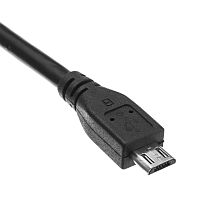
Keeping clients' computers safe and profitable for over 30 years
Home Forms About Current Newsletter subscribe
Search All Articles
Browse by Category

Types of USB Connectors
Article for: Everyone
Difficulty: moderate
Importance: It is useful to understand USB options and connectors. Possibly for reference only.
Difficulty: moderate
Importance: It is useful to understand USB options and connectors. Possibly for reference only.
USB stands for Universal Serial Bus. So, if it is universal, why are there so many different types? The last office computer I delivered had four different kinds of USB ports! That doesn't even begin to deal with the many kinds offered on mobile devices. Here's a guide. We break down the connectors into types and also standards.
This list is not complete, but should cover everything you are likely to run into.
Types
We can think of three types of USB connections.
The Host called type A. This is the controlling device. If it is charging, this will send the charge. It is the master. If printing, it will send the print job. We normally find these on computers. Below is a picture of a USB 2 type A cable.

The Slave called type B. This is the controlled device. It accepts the stuff coming from the host. If a printer, it accepts the print job. If a phone it accepts the charge from the host. Below is a USB 2 type B cable connection.

OTG: Naturally, this clear distinction was too simple for the computer world. So, they quickly added USB On-The-Go (OTG). This allowed your phone with its USB B port which will receive a charge, to become a master instead. It can host a mouse or keyboard if it connects with the proper OTG cable.
C: This is the newest type. We can plug it in either way, and usually supports Standard 3.1, but is downward compatible with an adapter.

Furthermore, the USB 3.1 and above Type C cables are fully bi-directional. They will negotiate who, if either, will be host or slave.
Shapes
Phones and other small devices require smaller connectors. So, we got the mini and then the micro USB connections.
Mini

Micro


Micro-B: These usually connect to standard 3 USB hard drives. Remember, the B indicates the slave or receiving device, not the controlling host device.


Standards (sometimes called Versions)
We have increased the speed and also the power that is transmitted. Newer specifications charge our devices quicker and send information faster.
USB 1.1: Old standard. I haven't seen any in years.
USB 2: Was the most common standard until a few years ago. This is 40 times faster than USB 1. USB 3 is faster, but this if fine for mice and keyboards, even most printers and scanners.
USB 3.x is 5 to 10 times faster than USB 2 and best for external drives, both hard drives and also flash drives. Normally they color the connectors blue to make them easy to identify. Sometimes they also label the devices with an SS for Super Speed. If you have an SS next to your USB port, figure it is fast.
The 3.x could be 3.0 or 3.1 or 3.2. They could transfer at speeds of 5 Gb/s or 10 Gb/s or 20 Gb/s.
- Gen 1 transfers at 5 Gb/s
- Gen 2 transfers at 10 Gb/s
- Gen 2x2 transfers at 20 Gb/s
Any of these could be 3.0 or 3.1 or 3.2. The seem to be intentionally trying to make sure nobody can figure it out.
Further Reading
- Make Use of Article
- Wikipedia
- LifeWire
- CMD Article. Very good.
Date: March 2019

This article is licensed under a Creative Commons Attribution-NoDerivs 3.0 Unported License.